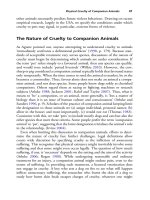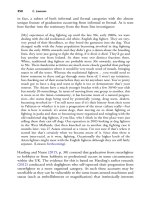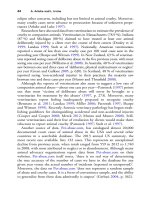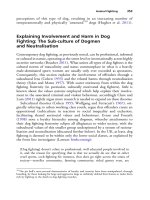The palgrave international handbook of a 195
Bạn đang xem bản rút gọn của tài liệu. Xem và tải ngay bản đầy đủ của tài liệu tại đây (26.2 KB, 1 trang )
188
N. Taylor and H. Fraser
sanctioned enslavement and slaughtering of animals. The irony here is how
easily the barbaric practices of domination and slaughter are pushed away
through laughter and scorn under the guise of intellectual and even ethical
supremacy. It is made possible by the associations of men with (trusted)
reason and women with (unruly) emotions.
Most western post-Enlightenment discourses still need to ‘civilise’ or
otherwise ‘discipline’ and control beings constructed as unruly and closer
to nature, classifications long attributed to women and other animals. The
same works in reverse with the assumption that nature is something ‘out
there’ to be ‘mastered’ by human practice, usually through technological
means, and this is evident in slaughterhouse work where the technology is
something to be proud of (Hamilton and Taylor 2013), something we will
return to later. The need to dominate and control nature—and anything and
anyone associated with it— is not only old but it is so deeply embedded
within modern thought as to be one of its constitutive paradigms. Far from
being considered an aberration, it is instead a belief system whereby oppression is considered a legitimate, and indeed necessary starting point. Murray
(2011), for example, points out that speciesist relations have been constitutive of capitalism, rather than an effect of it, in the same way that other
scholars argue that the very roots of modern capitalist practices have been
dependent upon the subjugation of women. This analytical approach allows
us to see the interconnected nature and consequences of animal and human
abuse and oppression. Cantor (2014, p. 30) succinctly summarises it: ‘animal
abuse is a root cause of even human miseries that do not appear linked at first
glance’.
Accepting that such violences are linked is challenging as it encourages a
different view of the role of violence—and specific violent events—in society.
Bauman (2001, pp. 4–5), for example, argued that traditional thinking and
scholarship that regard the holocaust through a ‘theoretical framework of
malfunction are misplaced, and possibly even dangerous’, as they can only
lead to a conception of ‘ . . . the Holocaust as a unique yet fully determined
product of a particular concatenation of social and psychological factors,
which led to a temporary suspension of the civilizational grip in which
human behaviour is normally held.’ This traditional understanding,
Bauman argued, offers an odd sense of comfort because the alternative is to
accept that such violence is endemic, normative and constitutive of our
current social organisation:
We suspect (even if we refuse to admit it) that the Holocaust could merely have
uncovered another face of the same modern society, whose other, more









